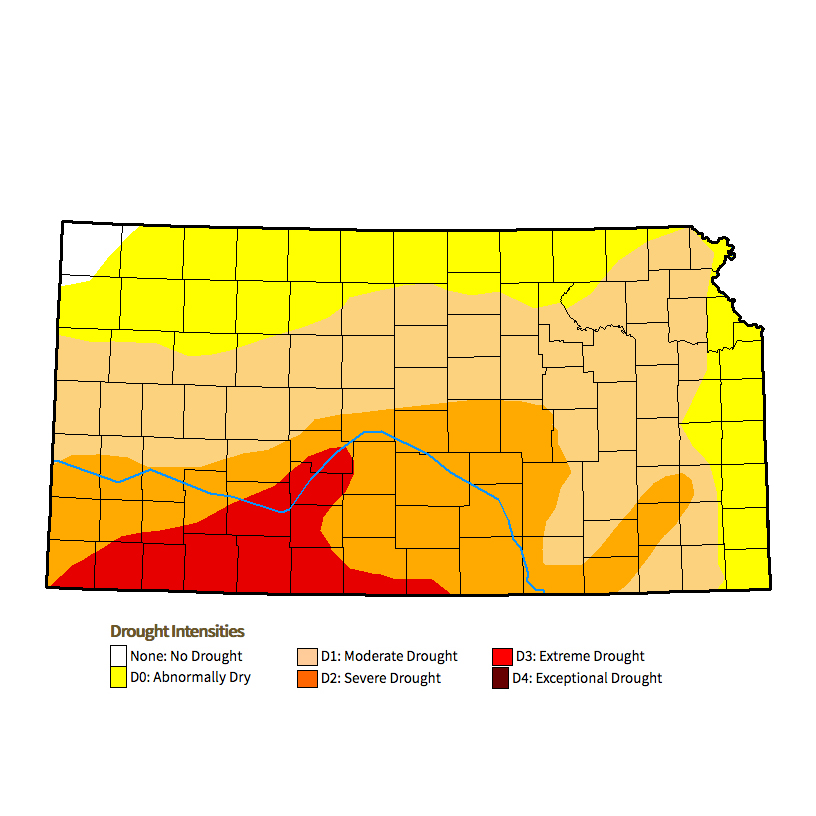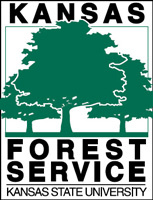
On Feb. 27, 2018, the National Integrated Drought Information System rated 73% of Kansas as being in moderate, severe or extreme drought conditions. Image from NIDIS. | Download this photo.
High winds, drought make this spring potentially combustible for much of Kansas
As fire season begins, Kansas Forest Service specialist warns of high risk
March 2, 2018
UPDATED: March 5, 2018
MANHATTAN, Kan. — An official with the Kansas Forest Service says an unusually dry winter has left parts of Kansas with a high risk of wildfire.
“We’re looking at an extended, unusually severe fire season this spring,” said Eric Ward, a fire planning specialist with the Kansas Forest Service in Manhattan. “There’s been a lot of fires already this spring, and the current climatological predictions are that fire season is going to continue probably into at least early May.”
The biggest concern is water, or the lack of it. The National Integrated Drought Information System compiles data from a multitude of state and federal agencies to provide information on current drought conditions and manages the Drought Early Warning System. The most recent snapshot of Kansas places more than 73 percent of the state in moderate, severe or extreme drought conditions. At the same time last year, those conditions were present in a little more than 37 percent of the state.
“The southern and western parts of the state – especially the far southwest – is just dangerously dry right now. This persistent dryness will make it much more difficult to stop any fire that does start,” Ward said.
Normally, at the end of winter, most areas of Kansas experience dry conditions. The cold winds of winter naturally dessicate most plant growth, even if it’s dormant. Ward said this year is different: Last year’s exceptional growing season produced a lot of vegetation in the spring and summer months, but then the precipitation suddenly stopped.
“I’ve been told that some areas of Kansas have now broken the state record for the most days without measurable precipitation,” he said. “So, thinking back to the Dust Bowl days of the 1930s, we have now beaten that.”
Continued dry conditions, along with soil that is still warming up after a cold winter, could also delay the emergence of new growth. Ward said the grass and lighter growth that tend to be the primary fuel for fires usually start to look like a golf course by mid-April around Kansas. “But that's very likely to be delayed until early May this year,” he said.
In preparation for the fire season ahead, the Kansas Forest Service has been joining forces with other agencies, including the Division of Emergency Management, the state fire marshal's office, the Kansas Interagency Wildfire Council, and several federal agencies. The neighboring Oklahoma Forestry Services is also sharing information.
When high winds and low moisture combined for elevated risk of fire as this season began, Ward encouraged local fire departments to call for far more help than they normally would – immediately – if any kind of fire were to develop. “Don't wait till you get there to see if you need help – just call for help,” he said.
“If it takes 20 minutes to get to the fire, and then call for more help, that may make the difference between stopping a fire and going home in a couple of hours and being there until Wednesday.”
For Kansans living in fire-prone areas, Ward said it’s best to make preparations early, following the “Ready, Set, Go” plan:
Ready – Look over your property for any potential fire hazards, such as dead plant debris, gutters full of leaves, or firewood stacked close to the house.
Set – “When we get into a situation like this weekend when there's a chance for catastrophic fires, make sure the cars are full of gas. Make sure you’ve set aside the important papers, the pictures, the wedding albums. Maybe stick them in a box so if you have to run out the door you can take that stuff with you,” Ward said. Also, if you have pets, make sure you have leashes, crates, a toy or two, along with food and fresh water.
Go – For Ward, this is non-negotiable: “If you get an evacuation order, do it now. Don't wait until later and say ‘well, we're going to stick around to see if it turns out OK.’ (Evacuating) is much safer for the public, and it's much safer for the emergency responders.” The longer you wait, the greater the risk that when things really get hot, it will be too dangerous to leave.
Ward cautioned that things are just getting started, and diligence will be required for the next several weeks: “This whole spring is going to be a problem.
“The last couple years, wildfires around Kansas received a lot of attention in the media, but every year in Kansas, homes burn down from wildfires,” he said. “It just doesn't get the attention it does other places.”


